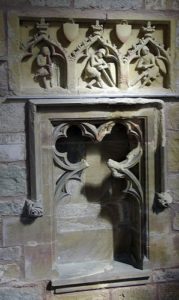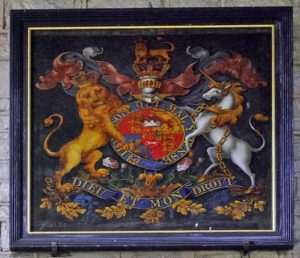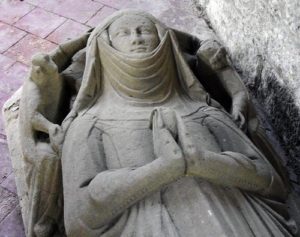Fledborough is in the depths of Nottinghamshire surrounded by power stations on the River Trent. It is reached by a narrow unclassified and unsigned road just south of Dunham. You will need the 1:50,000 map to find this. It is a small settlement of a few scattered houses at the end of the road.
It is a very nice decorated/early perpendicular church set in a large churchyard surrounded by yew trees and bird song. It has a large squat square tower at the west end with corner buttresses and small pyramid roof. On the south side is an intriguing small structure which is described as a bell cote but looks more like ventilation for a chimney. There are small double bell windows at the top of the tower with a small circular window above. Above the disused doorway at the west end is a narrow lancet window.
The base of the tower is 12thC, the rest of the church 14thC. The building is fairly plain outside with has nave with clerestory, side aisles, chancel with stone cross above the east end and south porch. The chancel was in a ruinous state by the late 18thC and had to be rebuilt. The blank wall at the east end of the south wall has traces of the chantry chapel which was demolished in 1764.
The inside is much better. There are bare stone walls and a wooden roof. Multangular pillars support pointed arches which separate nave and side aisles. There are paraffin lamps on the pillars and tall decorative candle sticks on the ends of the pews.
Immediately inside the door is a wooden poor box dated 1684. Near it is an octagonal stone font. On the floor is what is described as a floriate cross with carved branches with leaves and fruit which is 14/5thC and would have marked a grave. There are more grave slabs on the nave floor.
There is an empty stone sarcophagus under the tower and two more grave effigies in the north aisle. One is an early 14thC effigy of a woman in long flowing kirtle and wimple. Her hands are held in prayer and seem to be holding a heart. (In some websites this is described as being outside the east end of the south aisle.) In front of her is the top half of a 14thC knight. There is a crown carved on his body with a small heraldic shield below it.
On the north wall is a low carved arch with an inscription below it on the wall and a grave slab on the floor with a very worn carving of a foliate cross. This is thought to date from around 1300 and be Hugo of Normanton.
A narrow pointed arch leads into the bell tower. The only light comes from a narrow lancet stained glass window above the disused door. In the nave above the arch is a wooden panel with a painting of the Royal coat of arms. The wood ladder giving access to the bell chamber is still in place but doesn’t look very safe. Two of the bells are 14thC.
A small stone parapet separates nave and chancel and this extends into the stone pulpit on the north side.
The chancel floor is brightly coloured decorative tiles.
There is a wooden altar rail. The high altar is covered with a red cloth and a carved stone reredos extends across the width of the east wall. Marble pillars with carved capitals support pointed arches. Above the alter the central arch has a marble cross. To the left is the monogram IHS, to the right is what looks like a superimposed A and R.
The highlight in the chancel is the remains of the Easter Sepulchre on the north wall. This was basically a niche to house the blessed settlement after mass on Good Friday. The faithful kept continuous watch in the church until the early hours of Easter Day when the sacrament was transferred to the high altar. It is a liturgical drama symbolising the entombment and resurrection.
Above it are fragments of two carved panels. One shows the sleeping soldiers and the other has the risen Christ with angels. When the chancel was rebuilt in the 19thC the fragments were replaced as near as possible to their original positions.
The other highlight of the church is the 14thC stained glass. The east window in the north aisle is particularly fine. It has two long narrow windows separated by a blocked central window. This has a stone pedestal with an arch above and would have held a statue. The right window has a depiction of the Virgin and Child with a knight underneath. The left window has John the Baptist and St Andrew.
There are more pieces of 14thC glass in the aisle windows. One has a beautiful image of Mary holding Jesus with a figure holding a book next to her. The end window has an image of a knight with sword and club. There are heraldic shield in the quatrefoils of the north and south aisle windows.
The west window at the back of the south aisle is 19thC and has images of Christ in Majesty with Jesus and Mary Magdalene on the left and Jesus receiving small children on the right. The east wall of the south aisle is blank but the arch leading to the demolished Chantry chapel can be seen on the wall.
During the 18th century Fledborough gained a reputation as a destination for eloping couples and became known as 'the Gretna Green of Nottinghamshire'. Rev W Sweetaple, rector from 1721 to 1753, records in the church register a large number of marriages with "license granted by me."
This is a delightful church and well worth finding. The 14thC stained glass is beautiful.










